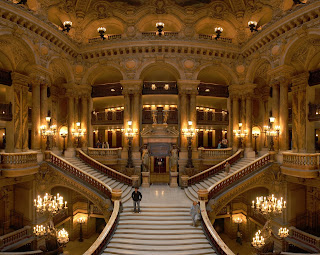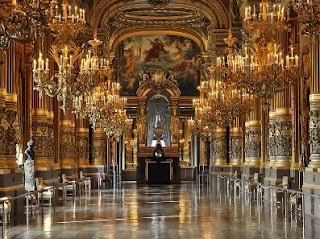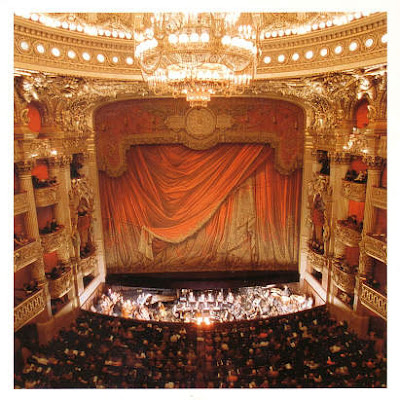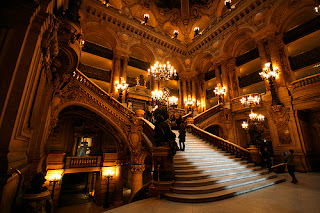 In 1858, Napoleon III decided to build the Grand Opera, for which Paris had long been awaiting, in the new business quarter designed by Baron Haussmann. The previous halls, since the foundation of the Académie Royale de Music, founded in 1669 by Louis XIV, had been either of temporary construction or had been destroyed by fires.
In 1858, Napoleon III decided to build the Grand Opera, for which Paris had long been awaiting, in the new business quarter designed by Baron Haussmann. The previous halls, since the foundation of the Académie Royale de Music, founded in 1669 by Louis XIV, had been either of temporary construction or had been destroyed by fires. On 29 December 1860, an architectural competition was organized for the new opera house. Of the 171 architects participating, Charles Garnier's design was the unanimous choice, maintaining a clear picture of the internal functions of the building in its external architecture, Garnier created an Opera House and stage in the traditional Italian style, and in a grandiose setting, inspired both by the Grand Theatre in Bordeaux built by Victor Louis in 1870 and by the Italian and French villas of the 17th and 18th centuries. The venue was intended to host the festivities of the Emperor's entourage and of elegant audiences from the moneyed and social élite, for whom a night at the Opera was a pleasant excuse for meeting people and renewing acquaintances. For this reason, the passages, halls, foyers, staircases, and rotundas occupy a far larger area than the theatre itself.
CHARLES GARNIER'S PROJECT
Construction started in 1861 and lasted for 14 years. The massive works were slowed down by the discovery of a water table that had to be drained before building an enormous concrete well designed to carry the gigantic stage and fly tower. The well was filled with water in order to counter the water pressure (hence the legend of the underground lake popularized by Gaston Leroux's Phantom of the Opera). The 1870 Franco-Prussian war and the Commune interrupted the construction works, but the fire at the old opera in Rue Le Peletier in 1873 hastened the completion of the monument. It was officially inaugurated during the Third Republic by Field Marshall de Mac-Mahon on 5 January 1875.
The building, which is a perfect example of 19th century stage architecture, hides its iron frame under flamboyant decoration. The overall impression is harmonious in spite of the diversity of its inspiration and the temes taken up by Charles Garnier. He personally supervised the integration in the architecture of decorative works entrusted to sculptors, painters and mosaic artists representative, as himself was, of state-sponsored artists.
TRIUMPH OF ECLECTICISM
Thanks to the diversity of the materials used in the building of the house, you're immediately struck by a full range of colours, right from the façade which opens into the fairy-tale world of the Opera House, to which the two side pavillions formerly also provided access: for the regular subscribers on one side and for the Emperor on the other. They are today occupied by the Library and the Opera Museum. At the right of the entrance halls, there is the famous group of dancers by Jean-Baptiste Carpeaux - the original is in the Musée d'Orsay. The great staircase continues down towards Pythia's water basin and the former subscribers' rotunda. The stairs are decorated in marble and onyx, a true theatre of worldly events, while the lobby is decorated with Venetian mosaics. Two small rooms, one dedicated to the Moon, the other to the Sun, lead to the main foyer, a princely gallery of gilded luxury in which the mythological characters and the allegories of Paul Baudry stand out. The rotunda is adorned by eight tapestries made by the Gobelins, under a ceiling by Georges Clairin. In the auditorium itself, the great chandelier illuminates the ceiling by Marc Chagall, which has, since 1964, covered the original work of Jules-Eugène Lenepveu. Echoing the colorful style dear to Charles Garnier's, Chagall has designed his painting as a living image of the festive spririt surrounding each performance: luminous, fluid figures surge forth, contrasting with the gold and red tones of the theatre.
 THE PARIS OPERA
THE PARIS OPERA
>From 1881 down to the present day, several restoration and modernization programmes have made the theatre increasingly functional without lessening its appeal as a monument: technical progress and the evolution of sets under the influence of "verism". The next step was the building of a modern and popular opera house: Opera Bastille
Addres:
Opera National de Paris8, Rue scribe 75 009 Paris,France.
Tel : +33(1) 44 73
Ticket prices:
- Category 1 590
- Category 2 470
- Category 3 315
- Category 4 210
- Category 5 130
- Category 6 60



















Posting Komentar